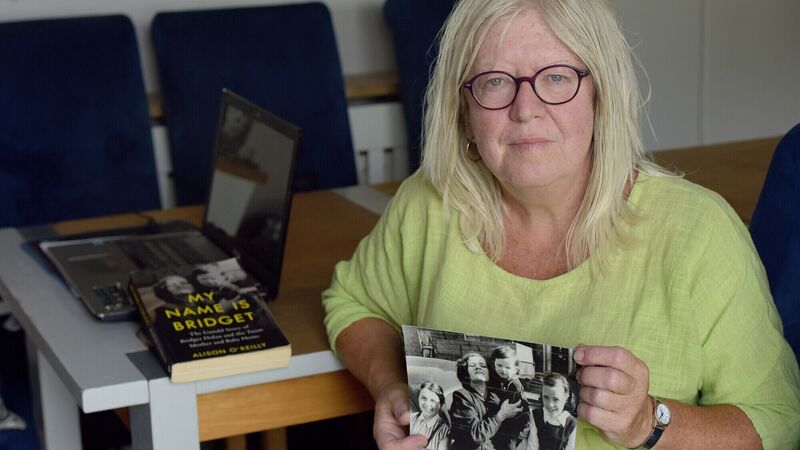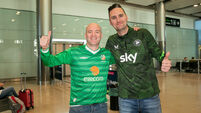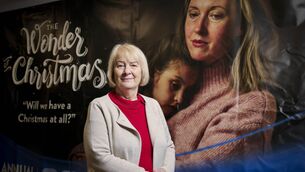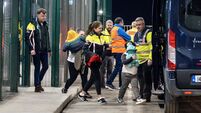Long-awaited exhumation at Tuam: 'I hope we can find all the children'

Anna Corrigan shares a photograph of her mother Bridget holding her as a girl. She believed she was an only child. Picture: Moya Nolan
Tears rolled down Anna Corrigan’s face as she sat alone at her kitchen table while the world learned last week that the long-awaited exhumation of the Tuam babies’ burial site would begin on Monday.
She had been told the information privately early on Wednesday by Daniel MacSweeney of the Office of the Director of Authorised Intervention, Tuam, and had discussed it with her family and the Tuam Babies Family Group, which she set up in 2014.
“We did it, we got it over the line, I am really trying to take it all in," she told the
Her two brothers John and William Dolan died in the home in 1947 and 1951, respectively.
They were a secret that her mother Bridget Dolan had taken to the grave when she died almost 20 years ago.
Bridget's only daughter discovered the information in 2012 and launched a campaign to help find her brothers alongside Galway historian Catherine Corless who uncovered the names of the 796 children who died in the Tuam home.

When news broke that the notorious burial site will come under forensic control on June 16, Anna said: “I never thought I’d see this day. I think my mother would be very proud that this is happening.
From Monday there will be no public access to the middle of the Dublin Rd housing estate in Tuam in Co Galway for at least 24 months — the residential homes were built there after the Tuam mother and baby home was closed down in 1961.
Hoarding will be put in place as a five-part phased project to excavate every inch of the area of interest gets under way.
A team of at least 18 will be on-site during the work, with specialist temperature and humidity-controlled equipment loaded in and a compound area for workers who will conduct the complex and pain-staking project.
Diggers and construction contractors will be preparing to open the ground under the supervision of some of the country’s top forensic archaeologists.
It will be the first ever mass grave exhumation here and what makes it unique is that “it involves hundreds of infants”, Mr MacSweeney said.
“We have had mass burials and graves of children in other countries, but this is unique because of the ages of the children," he said.
A test excavation at the site in October 2016 and January 2017 confirmed that samples taken from human remains buried in 18 of the 20-chamber disused sewage tanks were dated from the Tuam home period.
The ages of the children were between 35 foetal weeks and 2-3 years.
Niamh McCullagh, consultant forensic archaeologist who oversaw those test excavations, had recommended a full excavation at the time — which never happened.
The exhumation only came about following pressure from families, survivors, and campaigners.
The actual breaking of the ground will begin on July 14 after the preparation work is concluded.
Families and survivors will be invited to the site on July 8.
It is the end of an 11-year fight for the families who campaigned for the children to be taken out of the “hell hole” and given a respectful and dignified burial.
Anna was part of the original exposé of the Tuam Babies mass burial in 2014, when she revealed she had two older brothers who both died as infants in Tuam.
“John was born healthy and well in 1946, but died the following year of the measles and was described as a congenital idiot on his death cert," she said.
“William was born well too but is marked as dead in the ledgers, but no other records are there for him, he is a missing person and I've reported both of my brothers' cases to the gardaí."
The former Bons Secours religious-run institution housed unmarried mothers to be, as well as some children whose parents were deemed not fit to care for them.
The children were later adopted from the home, fostered (or boarded out) or died there, during its operation between 1925 to 1961.
Records show the Galway County Council was aware of the children’s grave and so was the order of the Bons Secours nuns, who wrote to Anna in 2013 to explain they had no idea where her brother John was buried, other than in the children's grave at the back of the former home.
“There has been obstruction and prevacation and I have been sent around the block, but we are here now today, ready to start the exhumation and all I can really say is shame on our State, shame on the religious for the way they treated innocent children and women.
Up until 2012, Anna spent her entire life believing she was an only child, but later discovered in her 60s as a grandmother, she was actually the youngest of three.
By then, her mother, from Clonfert, Co Galway, had passed away, and her father William Corrigan, who was incarcerated in his childhood in two industrial schools, had also died.
She discovered the information after researching her father’s life, as well as his siblings John and Molly who were all taken into the care of the State after their mother died.
Brothers William and John were locked up as children in the Kilkenny Industrial school as well as the notorious Glin industrial school in Co Limerick.
Their sister Molly was sent to the Mercy sisters’ industrial school in Loughrea where she died at 13 — her remains and grave have never been located despite extensive research by Anna.
The discovery of her brothers' existence is still as raw today for Anna.
“I vaguely remember someone saying to my mother when I was a child, during a row, that she had two sons,” she said.
“I was looking for my father’s history and the researcher in Origins in Barnardos rang me to say, that I was right, my mother did have two sons.
“It was close to Christmas and I nearly fainted when I was told, I just couldn’t believe it.
“My life changed in a flash, everything that was, then was not. My mother had never told me, I wish she did.
“I was too young to ever notice, or see her pain, I know now what she went through and if I had of known then I could have maybe helped sooner.”
Anna has provided her DNA to the forensic teams ahead of the exhumation, the latest figures show 14 DNA samples have been provided from family members, including one surviving mother, Chrissie Tully from Loughrea, who is 94 and searching for her son, Michael.

There have also been 50 inquiries from America and Canada about providing DNA.
Mr MacSweeney said he hopes that once the exhumation begins, more families will come forward.
However, Anna wanted to remind people that “these children were a secret”, and not everyone will know they are related to a baby who died in Tuam.
“That’s a big issue; there are people who have no clue they could be related to these children," she said.
“We need them to be matched to someone, hopefully more people will come forward.
“But for now, it is now time to take off our suit of armor and feel the emotion, I have not really cried for my brothers during this campaign.
“I kept fighting, making it about the campaign and the other family members in the Tuam Babies Family Group. I set up that group to help others.
“We are in this together as family and we are hugely grateful to Catherine [Corless] for her work, we stood with her to fight this battle.
“Now that it’s actually happening, I just hope we can find all the children."









